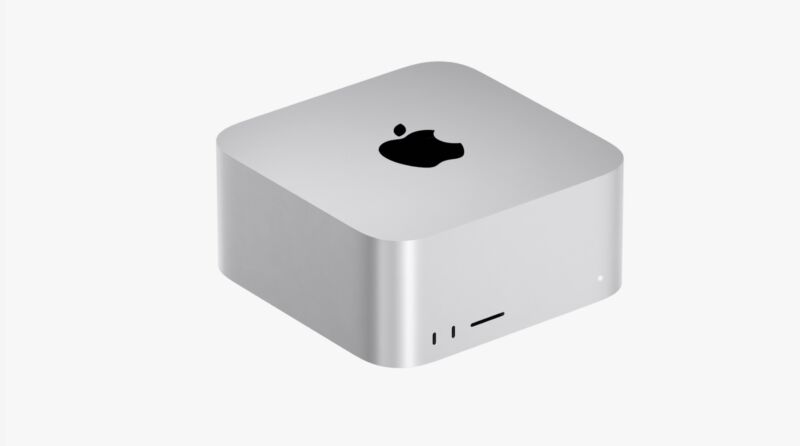

Apple announces $1,999 Mac Studio workstation with new 20-core M1 Ultra chip
source link: https://arstechnica.com/gadgets/2022/03/apple-announces-mac-studio-workstation-with-new-20-core-m1-ultra-chip/
Go to the source link to view the article. You can view the picture content, updated content and better typesetting reading experience. If the link is broken, please click the button below to view the snapshot at that time.

stu-stu-studio —
Apple announces $1,999 Mac Studio workstation with new 20-core M1 Ultra chip
New diminutive desktop can be even faster than the MacBook Pro, for a price.
Samuel Axon & Andrew Cunningham - 3/8/2022, 6:40 PM

For months, everyone has been speculating that Apple would soon update high-end, Intel-based Mac mini configurations with its own custom-designed silicon, and now Apple has announced just that at its spring product event. But what we got is actually a little more than what we expected.
The new desktop Mac is called the Mac Studio, and it's like a Mac mini, but bigger—bigger in size and bigger in performance. The thicker desktop comes in multiple configurations based on Apple's M1 Max and the new M1 Ultra processor, which doubles the CPU and GPU core counts of the M1 Max.
The more powerful chips allow the Studio to offer a dramatically upgraded array of ports, compared to the M1 Mac mini. On the back, you get four Thunderbolt 4 ports, a 10GB Ethernet port, two USB-A ports, HDMI, and a headphone jack. Those ports allow it to drive up to four of Apple's 6K ProDisplay XDR screens at once, plus a 4K screen using the HDMI port.
Another nice addition: unlike every other Mac desktop Apple has released in recent history, the Studio offers two easily accessible USB-C ports on the front, plus an SDXC card reader that will be handy for photographers.
The Mac Studio starts at $1,999, which will get you an M1 Max chip with 24 GPU cores, 32GB of memory, and a 512GB SSD. The M1 Ultra config starts at $3,999 and comes with 48 GPU cores, 64GB of RAM, and a 1TB SSD. Both will be available for preorder today and will begin shipping on March 18.
The Studio is also being introduced alongside a new first-party display from Apple, the 5K $1,599 Studio Display. We have more details on that in a separate post.
M1 Ultra: Two M1 Max chips strapped together
The M1 Ultra is a new design that uses "UltraFusion" technology to strap two M1 Max chips together, resulting in a huge processor that offers 16 high-performance CPU cores, 4 efficiency cores, a 48- or 64-core integrated GPU, and support for up to 128GB of RAM.
Advertisement
It's possible that Apple is using a chiplet-esque approach to the M1 Ultra, sort of like AMD is doing for many of its Ryzen chips. A chiplet-based approach, as we've written, uses multiple silicon dies to make larger chips and can result in better yields since you don't need to throw a whole monolithic 20-core chip out if a couple of cores have defects that keep them from working.
Like the other M1 chips, the M1 Ultra is manufactured on a 5nm TSMC manufacturing process. If you want to know the chip's other key specs, simply double everything Apple is doing in the M1 Max—that means up to 800GB/s of memory bandwidth and a 32-core Neural Engine.
Apple wasn't shy about comparing the Studio's performance to the Intel-based Mac Pro and 27-inch iMacs that it still sells: it says the M1 Max's CPU is "up to 2.5 times faster" than the 10-core Core i9 iMac and up to 50 percent faster than a 16-core Mac Pro. Its GPU performance is also said to be 3.4 times faster than the iMac's Radeon Pro 5700XT GPU. The M1 Ultra does even better: 3.8 times faster than the best 27-inch iMac and 90 percent faster than a 16-core Mac Pro.
The Studio one-ups the higher-core-count versions of the 2018 Intel Mac mini that Apple continues (!) to sell as of this writing. Though it hasn't been updated in over three years, the 2018 mini offers more USB and Thunderbolt ports, more external display outputs, and more RAM than the standard Mac mini's regular M1 chip is capable of handling. The M1 Max and Ultra allow the Studio to address all of those shortcomings while taking advantage of the performance and power efficiency improvements of Apple Silicon chips.
This isn't the first time in its modern history that Apple has ever tried to make a compact workstation—the Power Mac G4 Cube and the 2013 Mac Pro both come to mind, though both products were ill-fated in their own ways. But as a rule, for most of the 2000s there has been a wide performance gap between the tiny Mac mini and the hulking Power Mac and Mac Pro towers that Apple mostly tried to fill with the iMac and iMac Pro. As a computer that's more powerful than the standard mini and much cheaper than even the lowest-end Mac Pro, the $2,000 Studio in particular fills a "more cost-effective, screen-less workstation"-sized gap in Apple's lineup that the company has mostly been content to ignore.
Ars Technica may earn compensation for sales from links on this post through affiliate programs.
Recommend
About Joyk
Aggregate valuable and interesting links.
Joyk means Joy of geeK